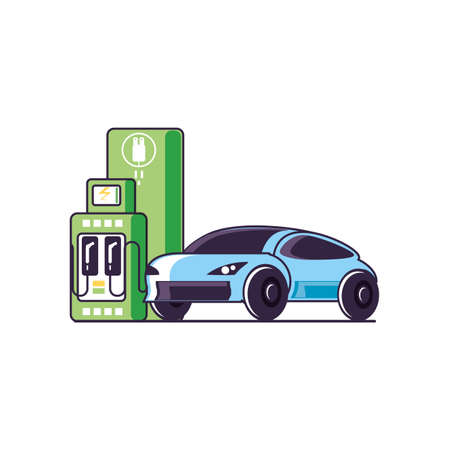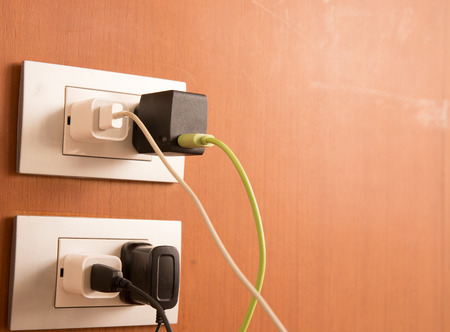Introduction: The Importance of Choosing the Right Home Charger
As electric vehicles (EVs) become increasingly popular across the UK, selecting the right home charger has never been more crucial for British drivers. The decision between tethered and untethered charging units impacts not just how conveniently you can top up your battery after a scenic road trip or daily commute, but also how seamlessly your charger integrates with your lifestyle. Factors such as cost-effectiveness, ease of use, and compatibility with different EV models all come into play. For those who enjoy exploring the countryside or simply want hassle-free charging at home, understanding these differences is essential. In this guide, we’ll break down why making an informed choice matters—whether you’re parking up in your driveway in London or setting out for a weekend camping adventure in the Lake District.
Understanding Tethered and Untethered Home Chargers
When considering a home EV charger for your UK driveway or garage, you’ll come across two main types: tethered and untethered units. Let’s break down what these terms mean, how they function, and the key differences that matter most to British EV owners.
Tethered Home Chargers
A tethered charger comes with a charging cable permanently attached to the unit—much like you’d find at many public rapid charging stations dotted around the UK. Simply uncoil the cable from the wall-mounted unit and plug it straight into your electric car. This is often the go-to choice for drivers who prefer convenience and have just one vehicle with a standard Type 2 socket (the norm for most UK EVs).
Untethered Home Chargers
An untethered (or ‘socket-only’) charger, on the other hand, has no fixed cable. Instead, it features a universal charging socket—meaning you’ll need to use your own Type 2 or Type 1 charging lead each time you charge up. This flexibility suits multi-car households or those expecting to swap between cars with different plug types over the years.
Side-by-Side Comparison
| Feature | Tethered Charger | Untethered Charger |
|---|---|---|
| Cable Included | Permanently attached (usually Type 2) | No – bring your own cable |
| Ease of Use | Plug in and go – less faff | Requires connecting separate cable each time |
| Compatibility | Best for single EV households with Type 2 inlet | Works with any compatible EV (Type 1 or Type 2) |
| Aesthetics & Tidiness | Cable can look untidy when not stowed neatly | Sleeker look when not in use – just a socket on the wall |
| Theft Risk | Low (cable fixed in place) | Higher (removable cables can be pinched if left outside) |
UK Example: Choosing What Suits Your Driveway
If you drive something like a Nissan Leaf or Jaguar I-PACE and only plan to charge at home, a tethered unit may make life easier—just as you’d expect from a British plug-and-play approach. However, if you’re hosting guests with other EVs or expect to change cars regularly (perhaps due to company car swaps), an untethered unit offers that classic British flexibility. Consider what fits best with your household routine before making your pick.

3. Pros and Cons: Tethered vs Untethered Chargers in the UK
When weighing up whether to go for a tethered or untethered home EV charger, its crucial to consider factors unique to British life—like our unpredictable weather, typical driveway layouts, and those little everyday habits that make a big difference. Below, we break down the key pros and cons of each option with a true UK perspective.
| Feature | Tethered Charger | Untethered Charger |
|---|---|---|
| Weather Resistance | Generally robust; cable is designed to withstand rain, sleet, and the odd hailstorm—a must for UK winters. | Cable kept indoors when not charging, so less wear-and-tear from weather, but more faff getting it out and about. |
| Driveway Setup | Ideal for regular parking spots—just plug in and you’re sorted. Less flexible if you have multiple vehicles or shift your car around. | Brilliant for shared driveways or changing parking spots, as you can take the cable with you or store it away tidily. |
| Everyday Practicality | No messing about—cable’s always ready to go. Less chance of misplacing it after a weekend trip to the Lakes. | More flexibility if you’ve different EVs or want to future-proof your set-up, but means extra steps each time you charge. |
| Aesthetics & Tidiness | Cable usually hangs on the wall; can look messy if not coiled properly—might not suit every front garden style. | Sleeker wallbox appearance; no trailing cables when not in use—keeps things looking shipshape. |
| Security | Cable is fixed, so less likely to wander off (though nothing’s impossible). Just mind the local foxes don’t chew on it! | Cables need storing securely inside to avoid theft or damage—especially important if you park kerbside. |
In summary, tethered chargers are often favoured by those who value convenience and speed—just park up and plug in, come rain or shine. However, untethered units win points for flexibility, discreet looks, and future-proofing, especially for those with multiple EVs or who want a neater finish outside their home. Ultimately, the best choice comes down to your daily routine and how much you enjoy a bit of British order versus ease of use after a blustery day out exploring the countryside.
4. Cost, Installation, and Grant Eligibility
When choosing between tethered and untethered home EV chargers in the UK, cost, installation logistics, and eligibility for government grants like the Electric Vehicle Homecharge Scheme (EVHS) are all crucial factors. Here’s how these elements stack up:
Price Differences
| Charger Type | Typical Cost Range (Hardware) | Average Installation Fee |
|---|---|---|
| Tethered | £500–£900 | £300–£500 |
| Untethered | £450–£850 | £300–£500 |
Tethered units are often slightly more expensive due to the integrated cable, but the difference isn’t dramatic. Untethered options give you flexibility if you plan to change vehicles frequently or want a neater look.
Installation Requirements
- Tethered Chargers: Require enough space near your parking area to mount both the charger and store the attached cable safely when not in use. They’re generally straightforward to install by an OZEV-approved electrician.
- Untethered Chargers: Offer greater flexibility in positioning since the cable is detachable. However, you’ll need to purchase a compatible charging cable separately if one is not supplied with your vehicle.
Grant Eligibility: EVHS & Local Incentives
The UK government’s Electric Vehicle Homecharge Scheme (EVHS) offers up to £350 off the cost of purchasing and installing eligible home charging points. Both tethered and untethered chargers qualify for this grant, provided they’re installed by an OZEV-authorised installer and meet specific technical requirements.
| Criteria | Tethered Charger | Untethered Charger |
|---|---|---|
| Eligible for EVHS? | Yes (if OZEV-approved) | Yes (if OZEV-approved) |
| Eligible for regional/energy supplier incentives? | Yes (varies by region) | Yes (varies by region) |
| Cable included? | Yes (fixed) | No (usually separate) |
If you’re in Scotland, there may be additional top-up grants available through Energy Saving Trust. Always check with your local council or energy provider, as some offer further incentives or discounts for home charger installations.
Selecting the right charger type means weighing upfront costs against long-term convenience and ensuring you take full advantage of available grants—making it a practical decision for any UK EV owner keen to charge at home.
5. User Experience: What UK EV Owners Say
When it comes to everyday life on Britain’s roads—whether you’re darting through the M25 in a Nissan Leaf, heading up the Lake District in your Kia e-Niro, or packing up the family for a Cornish camping holiday in your Tesla Model Y—the home charging experience really matters. Real-world feedback from UK drivers paints a practical picture of how tethered and untethered chargers fit into local lifestyles.
Everyday Convenience and Security
Many British EV owners cite the hassle-free convenience of tethered chargers as a big plus, especially for daily commutes. Plugging straight in after a long day is something drivers appreciate, particularly during chilly winter evenings. However, some urban dwellers—those with on-street parking or shared driveways—prefer untethered chargers for their tidy appearance and reduced risk of cable theft or vandalism, which can be a concern in busy town centres.
Compatibility with Popular UK Models
| Car Model | Tethered Charger | Untethered Charger |
|---|---|---|
| Nissan Leaf (Type 1/Type 2) | Compatible with Type 1 or 2 leads; easy for repeat users | Flexible—use any lead you own; ideal for mixed-EV households |
| Tesla Model 3/Y (Type 2) | Seamless charging; minimal fuss for daily use | Great if you want to take the cable on road trips or caravan sites |
| Kia e-Niro/EV6 (Type 2) | No need to fetch a cable—just plug and go | Adaptable if you have guests or switch between vehicles |
UK Commuting & Holiday Habits
For those clocking up miles across counties or heading off-grid to scenic campsites, untethered chargers offer flexibility—you can bring along your cable to use at destination chargers or public points. On the flip side, many families who stick to regular routines prefer tethered units for sheer ease, especially when wrangling kids and kit after a weekend away.
Feedback Snapshot: Tethered vs Untethered Preferences
- Tethered: Favoured by suburban households with secure driveways, valuing speed and simplicity.
- Untethered: Preferred by city residents and those who share chargers with multiple vehicle types or visitors.
The consensus? There’s no one-size-fits-all answer—but understanding these real-life experiences helps UK EV owners choose the setup that’ll best suit their travels, whether it’s a morning commute into London or an adventure to the Scottish Highlands.
6. Which Charger Suits Your British Lifestyle?
Choosing between a tethered and untethered home EV charger is more than just a tech decision—its about what fits your everyday life in the UK. Whether you live in a bustling city, a leafy suburb, or out in the countryside, and whether you park on-street or have a private driveway, each scenario influences the best charger for you. Here’s how to weigh up your options:
Urban vs Rural Living
| Location | Tethered Charger | Untethered Charger |
|---|---|---|
| Urban (City/Town) | Ideal for quick, convenient plug-ins when returning from work or errands; reduces faff with cables. | Best if public charging is common or you might share your charger with friends who drive different EVs. |
| Rural (Village/Countryside) | Great for dedicated driveways where security isn’t a concern; always ready for longer journeys. | Flexible for guests and future vehicle upgrades; easily tidied away from unpredictable weather. |
On-Street vs Driveway Parking
| Parking Situation | Tethered Charger Advantages | Untethered Charger Advantages |
|---|---|---|
| Driveway/Parked Off-Road | No need to fetch your cable each time; perfect for regular, hassle-free charging at home. | No unsightly cables left outside; safer from theft or vandalism in exposed areas. |
| On-Street Parking | Cable may be at risk of damage/theft; less discreet installation. | Easier to store the cable securely indoors; can adapt to council rules on street furniture. |
Future-Proofing for New EV Models
If you’re planning to upgrade your electric car or have family members with different brands, an untethered charger gives flexibility—just swap out the cable for different connectors. Tethered chargers are often compatible with most current UK models (especially Type 2), but if you want to stay ahead of new tech or anticipate getting a second EV, untethered might be more future-proof.
Quick Tips for British Drivers:
- Got guests or thinking of switching cars? Untethered keeps options open.
- Love convenience and always use the same car? Tethered saves time every charge-up.
- Lack off-street parking? Consider portable solutions or consult your local council about on-street charging permissions.
- Keen on keeping things tidy? Untethered chargers are easier to hide away after use, especially in smaller properties typical of many UK towns.
The Bottom Line:
The “best” home charger comes down to your postcode, parking setup, and how likely you are to change vehicles. Take stock of your daily routine—and remember, both options will keep you exploring Britain’s roads with zero tailpipe emissions!
7. Conclusion: Making the Best Choice for UK EV Owners
Choosing between tethered and untethered home chargers is a significant decision for electric vehicle owners in Britain, as it impacts daily convenience, long-term flexibility, and overall EV experience. To help you decide, here’s a summary of key considerations:
| Feature | Tethered Charger | Untethered Charger |
|---|---|---|
| Ease of Use | Always ready to plug in; no need to fetch your own cable | Requires attaching your separate cable each time |
| Aesthetics & Tidy Look | May appear bulkier due to attached cable | Sleeker look; no permanent cable on display |
| Future-proofing | Cable type fixed (usually Type 2); may not suit future vehicles with different connectors | Flexibility to change or upgrade cables as needed |
| Security | Cable always present—potential target for theft if not properly secured | No cable left outside; safer from theft or weather damage |
| Cost | Slightly higher upfront due to included cable | Cable purchased separately; can be replaced independently if damaged |
When making your choice, consider your current vehicle’s connector type, plans for future EVs, the layout of your driveway or parking space, and whether you value convenience over aesthetics. For families juggling multiple EVs with different charging requirements, an untethered charger might offer greater versatility. However, if simplicity and speed are paramount—especially after a long trek across the Lake District—a tethered unit could make life easier.
Ultimately, both options support the British ethos of practical innovation and eco-friendly travel. Whatever you choose, investing in a reliable home charger is a step towards greener journeys and more freedom to explore everything the UK has to offer. Here’s to many smooth miles ahead, whether you’re heading for the Scottish Highlands or a Cornish campsite!


